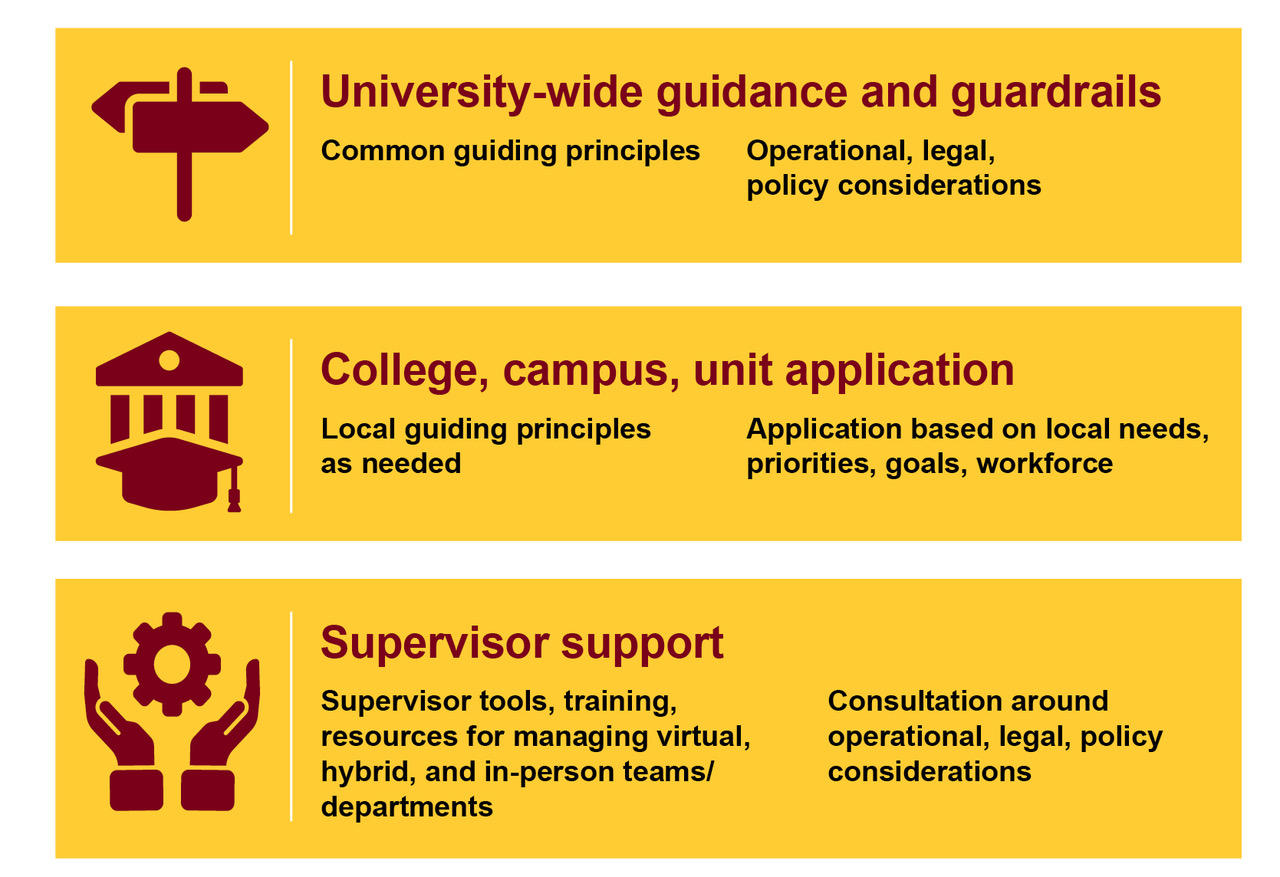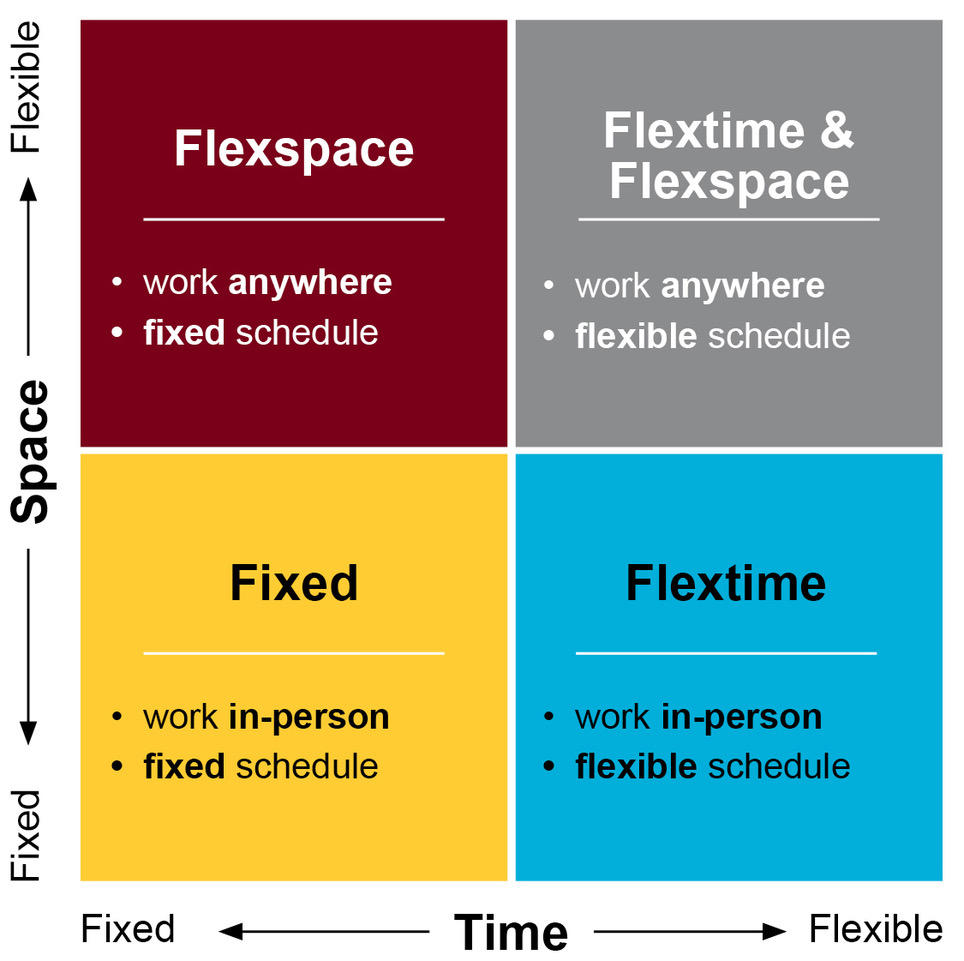Defining Local Flexible Work Options
Flexible work refers to the time and place that work is conducted. These flexible work arrangements can enhance engagement, performance, and retention, and attract the best talent. As unit leaders and supervisors make decisions about flexible work, they should do so by first evaluating the work.
- Consider both individual and collective productivity.
- Prioritize highly effective advancement delivery of our mission.
- Assess the impact of flexible work arrangements on responsiveness to the needs of students, staff, faculty, and/or community members. customer service or other similar values in making decisions.
Flexible work arrangements work best when processes and decisions are transparent and clearly communicated. Listening to faculty and staff and making their input a part of the process will lead to the best initial model.
Training and other tools from OHR are available to support supervisors and leaders in making informed decisions that foster employee engagement and productivity among teams with flexible work arrangements.
Flexibility for Where and When Work is Performed
Work. With Flexibility. considers both space and time options, from fixed to flexible, which can be illustrated by looking at four quadrants of when and where work is performed.
Options for Individual Faculty or Staff
Space
- Fixed space: work in-person on-site in a traditional workplace
- Flexspace: work anywhere (home, other designated space) using virtual technology; also known as remote work or work from home
- Hybrid space: combine fixed and flexible space options
Time
- Fixed time: work a fixed, consistent schedule
- Flextime: work can be completed using flex schedule/flex time, compressed work week, reduced work week, reduced work year, or job sharing. It can include setting work hours that might differ from the official business hours for a campus, college, or unit, including. but not limited to:
- Set hours worked, such as 7:00 a.m. to 3:00 p.m., or 9:00 a.m. to 5:00 p.m.
- Adding break times to the day, such as working from 7:00 to 11:00 a.m. and 1:00 to 5:00 p.m.
- Hybrid time: combine fixed and flexible time options, such as a five-day schedule during the academic year and compressed four-day work week during the summer
Team or Department Options
The type of work that needs to be accomplished may result in some members of a department or unit having different space and time options across its members.
- Traditional team: everyone in the department works in-person on the same schedule
- Flex team: everyone in the department uses flextime and flexspace options
- Hybrid team: the unit has a variety of fixed, flexspace/flextime, and hybrid space and time options within the same team or department
Common Flexible Options
- Flex Schedule/Flex Time. A flex schedule/flex time refers to an arrangement that permits variations in start and departure times but does not alter the total number of hours or days worked in a work week.
- Compressed Work Week. A compressed work week refers to a schedule where the total number of hours worked each week are conducted in fewer than five full workdays. The most common compressed schedule is four 10-hour workdays per week.
- Reduced Work Week (Part-time)/Reduced Work Year. A reduced work week or reduced work year is an arrangement that allows an employee to reduce their time commitment to the University on a permanent or temporary basis (e.g., reduction from 1.0 FTE to .75 FTE or a 12-month to 9-month appointment). Consultation with an Employee and Labor Relations representative in OHR is available to assist in determining feasibility, duration of time, and impact on pay, benefits, and/or taxes, as well as if there are other policies that may apply to the request.
- Remote Work/Flex Space. Remote work refers to an arrangement that allows an employee to work at home or from another off-site location. This could include working from a remote location all of the time, on an occasional basis, or a hybrid arrangement where the employee’s schedule includes a blend of remote work and work at a University location.
- Job Sharing. Job Sharing refers to a form of regular part-time work in which two people share the responsibilities of one regular full-time position. Job responsibilities, tasks, and hours may be split evenly or unevenly between the two individuals. Consultation with an Employee and Labor Relations representative in OHR is required to assist in determining feasibility, duration of time, and impact on pay and benefits, as well as if there are other policies that may apply to the request.

